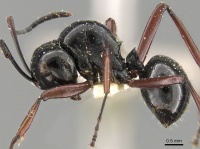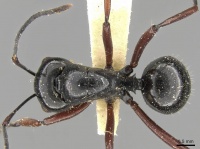Polyrhachis pilosa
| Polyrhachis pilosa | |
|---|---|

| |
| Scientific classification | |
| Kingdom: | Animalia |
| Phylum: | Arthropoda |
| Class: | Insecta |
| Order: | Hymenoptera |
| Family: | Formicidae |
| Subfamily: | Formicinae |
| Tribe: | Camponotini |
| Genus: | Polyrhachis |
| Subgenus: | Cyrtomyrma |
| Species: | P. pilosa |
| Binomial name | |
| Polyrhachis pilosa Donisthorpe, 1938 | |
Opportunistic in choosing its nesting sites, in recent years Polyrhachis pilosa has become increasingly common in suburban parks and gardens, with their silk nests built not only between leaves, but also in various artificial cavities around houses, including door and window frames (Kohout 2006).
Identification
Polyrhachis pilosa is similar to Polyrhachis mackayi both having an evenly convex mesosomal dorsum, a completely unarmed propodeum and subequal petiolar spines. However, the former is easily distinguished by the cover of relatively long, erect hairs on the dorsum of the head and mesosoma (Kohout 2006).
Keys including this Species
Distribution
The main distribution of P. pilosa is similar to that of Polyrhachis mackayi, reaching its southern limit at about Taree in northern New South Wales. In the north P. pilosa appears to be rather patchily distributed, with confirmed records from around Townsville and as far north and west as Fourty Mile Scrub and Undara (ANA). (Kohout 2006)
Latitudinal Distribution Pattern
Latitudinal Range: -14.066° to -31.966°.
| North Temperate |
North Subtropical |
Tropical | South Subtropical |
South Temperate |
- Source: AntMaps
Distribution based on Regional Taxon Lists
Australasian Region: Australia (type locality).
Distribution based on AntMaps
Distribution based on AntWeb specimens
Check data from AntWeb
Countries Occupied
| Number of countries occupied by this species based on AntWiki Regional Taxon Lists. In general, fewer countries occupied indicates a narrower range, while more countries indicates a more widespread species. |

|
Estimated Abundance
| Relative abundance based on number of AntMaps records per species (this species within the purple bar). Fewer records (to the left) indicates a less abundant/encountered species while more records (to the right) indicates more abundant/encountered species. |

|
Elevation Range
| Species | Elevation (m asl) | |||||
|---|---|---|---|---|---|---|
| 200 | 400 | 600 | 800 | 1000 | 1200 | |
| Polyrhachis pilosa | 20-30 | |||||
| Shading indicates the bands of elevation where species was recorded. Numbers are the percentage of total samples containing this species. | ||||||
Abundance
Common within its main range (~ south of Townsville to Taree).
Biology
Castes
Nomenclature
The following information is derived from Barry Bolton's Online Catalogue of the Ants of the World.
- pilosa. Polyrhachis (Cyrtomyrma) rastellata var. pilosa Donisthorpe, 1938c: 256 (w.) AUSTRALIA. [First available use of Polyrhachis rastellata r. laevior var. pilosa Forel, 1902h: 527; unavailable name (Taylor, 1986: 34).] Raised to species: Kohout & Taylor, 1990: 518. See also: Kohout, 2006b: 102.
Type Material
- Polyrhachis (Cyrtomyrma) rastellata pilosa Donisthorpe, 1938: Syntype, worker(s), Wollongbar, Richmond River, New South Wales, Australia, American Museum of Natural History.
- Polyrhachis (Cyrtomyrma) rastellata pilosa Donisthorpe, 1938: Syntype, worker(s), Wollongbar, Richmond River, New South Wales, Australia, Australian National Insect Collection.
- Polyrhachis (Cyrtomyrma) rastellata pilosa Donisthorpe, 1938: Syntype, worker(s), Wollongbar, Richmond River, New South Wales, Australia, Musee d'Histoire Naturelle Genève.
- Polyrhachis (Cyrtomyrma) rastellata pilosa Donisthorpe, 1938: Syntype, worker(s), Wollongbar, Richmond River, New South Wales, Australia, Naturhistoriska Riksmuseet.
Description
Worker
Metanotum sans trace d'epines. Tres semblable a la var. debelis Emery, mais tout le corps assez abondamment pourvu de poils dresses fins. Ca et la meme un poil sur les pattes. (Forel 1902)
Type Material
Wollongbar, Richmond River NEW SOUTH WALES, col. Froggatt. Syntype workers from American Museum of Natural History examined by Kohout (2006).
References
- Burwell, C.J., Nakamura, A. 2020. Rainforest ants (Hymenoptera: Formicidae) along an elevational gradient at Eungella in the Clarke Range, Central Queensland coast, Australia. Proceedings of the Royal Society of Queensland 125: 43-63.
- Donisthorpe, H. 1938c. The subgenus Cyrtomyrma Forel of Polyrhachis Smith, and descriptions of new species, etc. Ann. Mag. Nat. Hist. 11(1): 246-267 (page 256, worker described)
- Forel, A. 1902. Fourmis nouvelles d’Australie. Revue Suisse de Zoologie 10: 405-548.
- Kohout, R. J. 2006. Review of Polyrhachis (Cyrtomyrma) Forel (Hymenoptera: Formicidae: Formicinae) of Australia, Borneo, New Guinea and the Solomon Islands with descriptions of new species. Memoirs of the Queensland Museum. 52:87-146.
- Kohout, R. J.; Taylor, R. W. 1990. Notes on Australian ants of the genus Polyrhachis Fr. Smith, with a synonymic list of the species (Hymenoptera: Formicidae: Formicinae). Mem. Qld. Mus. 28: 509-522 (page 518, Raised to species)
References based on Global Ant Biodiversity Informatics
- Kohout R. J., and R. W. Taylor. 1990. Notes on Australian ants of the genus Polyrhachis Fr. Smith, with a synonymic list of the species (Hymenoptera: Formicidae: Formicinae). Memoirs of the Queensland Museum 28: 509-522.
- Robson Simon Ant Collection, 05-Sept-2014

